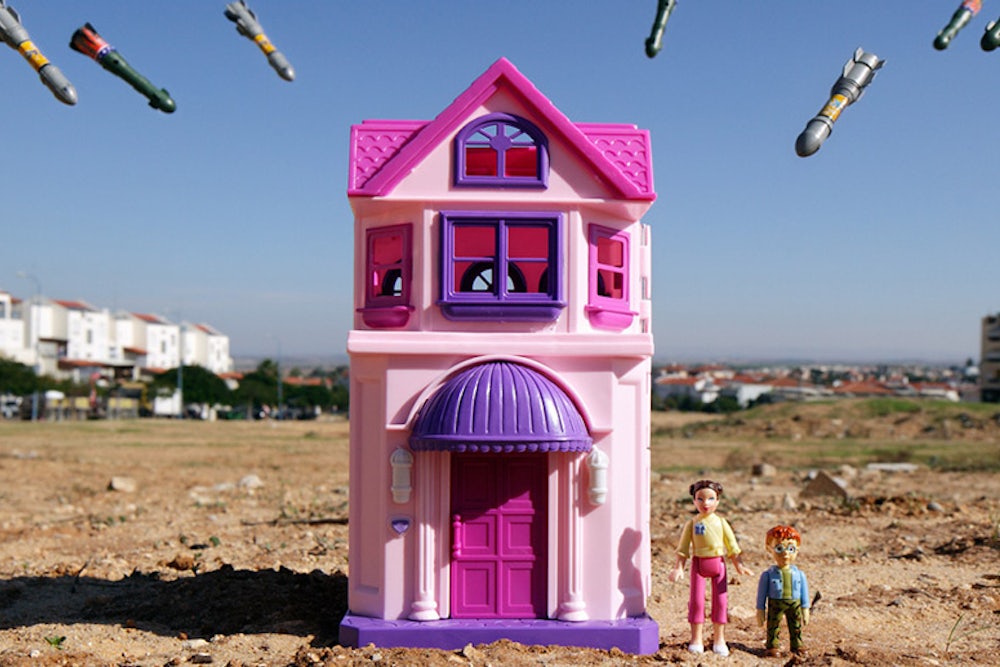In 2012, a nine-year-old girl at the Asma Elementary School in Gaza City put crayon to paper. She drew Israeli soldiers with guns, a tank, and a dead Palestinian holding up a flag, a pool of blood seeping from his body. She also drew a Palestinian mother being escorted away by soldiers, a baby in her arms. American photographer Brian McCarty adapted this drawing in a staged photograph for his project War-Toys, a series that takes us through children’s memories of violence and conflict. Since 2011, McCarty has traveled to war zones and, with the help of NGOs and therapists, has interviewed children affected by the ongoing violence. The reenactment of their drawings constitutes a poignant examination of trauma as experienced by the most vulnerable segment of the population.


McCarty has photographed toys for commercial clients such as Mattel and the Cartoon Network for years. It was in the late '90s, however, that he became aware of the use of toys, art, and play therapy to treat traumatized children in zones of conflict. “In severe cases, these boys and girls lose the ability to speak altogether. A trained therapist armed with little more than crayons and paper can open up pathways for communication and healing. I decided to purposefully collaborate with these children and invite them to become my art directors,” he told me.

The process begins with the children being interviewed, after which they recreate their memory in a drawing. “In areas where the children are most traumatized, they’ll often hide the most important or impactful elements, almost as if to protect them. When revealed, I listen and take that as my direction.” He uses locally purchased toys for the shoots to reflect the children’s reality and socio-economic condition. These are also the same toys the children have to play with, obtained in places they know.

In 2012, several young sons of fishermen who attended an elementary school in the Gaza Strip drew themselves being fired on by Israeli forces enforcing a naval blockade. Their scene was complete with dead bodies on the beach. In their interviews, however, they boys focused on the plight of the fishermen. McCarty took that as his cue for the photograph. “With the four boys killed last week in front of the Al-Deira Hotel in Gaza City, it seems prophetic now,” he added.

One of the biggest challenges McCarty faces is gaining access to the NGOs. It takes a lot of persistence, navigating of red tape, and connections. The organizations often have limited resources, and accommodating this kind of project is usually not high on their list of priorities.

The security situation is another major challenge. McCarty re-enacts these scenes close to the where they originally happened. In 2012, he was working on this project during the escalation leading up to “Operation Pillar of Defense” in the Gaza Strip, at locations often targeted by IDF forces; air strikes often happened nearby. “I saw a few things I wish I could un-see," he says, "and felt some of the fear and anxiety that the children experience throughout their lives.”

McCarty plans to expand the project to other conflict zones, like Afghanistan, South Sudan, Colombia, and Syria (working with refugees in Jordan and Lebanon). “In many ways, War-Toys was designed to sneak around people’s defenses and present the realities of war in a more digestible way—through a playful filter. When confronted with graphic images showing true costs of war, most people turn away—literally and metaphorically. … Having toys act out these horrors provides a spoonful of sugar to help some very scary truths go down and get internalized. Once inside, I hope they invoke new ways of thinking."


Though this project might seem highly political, McCarty tries to remain neutral, and attempts to experience the conflict exclusively from the children’s point of view. “Whoever is shooting at the children (and me) is the ‘bad guy,’ plain and simple … In the moment when trauma occurs, ideology or flag matters little.”

